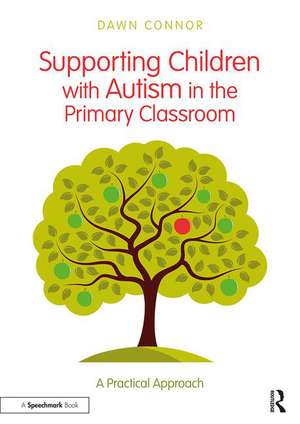Supporting Children with Autism in the Primary Classroom: A Practical Approach
Autor Dawn Connoren Limba Engleză Paperback – 26 oct 2018
Each chapter in the book addresses some of the most common social, practical and behavioural difficulties that a child with autism may face at school, and details tried and tested approaches for improving their experiences and outcomes in your classroom. Topics discussed include:
- classroom layout, timetables and rules
- effective communication
- supporting learning and setting targets
- breaks, unstructured times and school trips
- challenging behaviours
Preț: 287.87 lei
Nou
55.09€ • 59.82$ • 46.28£
Carte disponibilă
Livrare economică 01-15 aprilie
Livrare express 18-22 martie pentru 29.19 lei
Specificații
ISBN-10: 1138559504
Pagini: 118
Ilustrații: 9 Tables, black and white; 1 Line drawings, black and white; 1 Halftones, black and white
Dimensiuni: 210 x 297 x 10 mm
Greutate: 0.36 kg
Ediția:1
Editura: Taylor & Francis
Colecția Routledge
Locul publicării:Oxford, United Kingdom
Public țintă
Postgraduate, Professional, and Professional Practice & DevelopmentCuprins
Recenzii
Professor Jean MacLellan O.B.E. - Autism Network Scotland, University of Strathclyde.
Notă biografică
Descriere
This invaluable resource offers a wealth of strategies enabling you to support children with autism in the mainstream classroom. Cutting through the jargon and recognising the huge variety of ways in which children's perceptions, feelings and behaviours may be affected by autism, the text is packed with practical advice to help you create a classroom environment which will meet the needs of the individual child.
Each chapter in the book addresses some of the most common social, practical and behavioural difficulties that a child with autism may face at school, and details tried and tested approaches for improving their experiences and outcomes in your classroom. Topics discussed include:
- classroom layout, timetables and rules
- effective communication
- supporting learning and setting targets
- breaks, unstructured times and school trips
- challenging behaviours
Supporting Children with Autism in the Primary Classroom - A Practical Approach is a highly accessible resource which will give primary teachers, teaching assistants, SENCOs, and parents, the confidence and knowledge they need to support young children with autism.
